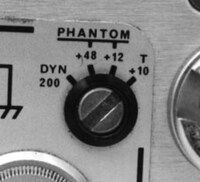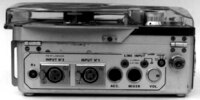 Nagras could be ordered or equipped with a choice of two regular pre-amps, two 3-5s, or one of each. An end user could specify what they wanted when ordering or renting. Remember though, a condenser mic with a power supply will work with the regular pre-amp, but a dynamic or electret mic will not work with a QPM 3-5 (T-power).You’ll get no audio! So don’t lock yourself in to using the QPM 3-5 pre-amp unless you are certain that only condensers are going to be used on the shoot.
Nagras could be ordered or equipped with a choice of two regular pre-amps, two 3-5s, or one of each. An end user could specify what they wanted when ordering or renting. Remember though, a condenser mic with a power supply will work with the regular pre-amp, but a dynamic or electret mic will not work with a QPM 3-5 (T-power).You’ll get no audio! So don’t lock yourself in to using the QPM 3-5 pre-amp unless you are certain that only condensers are going to be used on the shoot.
Later Nagras could be equipped with the Universal pre-amps (QPAU-T/QPU-T). These pre-amps are switchable and can be selected for use with dynamic, T-powered or Phantom powered mics. The QPAU-T is the mother pre-amp and is found in the Mic One position only. To change between mic settings, there is a slotted adjustment switch near the left side corner. The QPU-T pre-amp is for Mic Two only, and is adjustable from the inside of the machine. Ask a technician to show you how it works.
If you are using a Nagra with Universal pre-amps, and the mic doesn’t work, make sure the pre-amp selector switch is in the correct position. A hint: dynamic is at one extreme of the switch and T-powering is at the opposite extreme.
Another interesting means of powering a mic from a Nagra is to employ a KAT cable amplifier (made at one time by Sennheiser). This small device plugs into the accessory socket of the Nagra and takes its power directly from the machine. The power drain on the Nagra is negligible. The KAT, besides providing T-powering, also expands the capability of the Nagra because it converts the line input pot into an additional microphone input. The KAT is switchable for use with either condensers or regular dynamic mics.
Now here is the great source of confusion. Nagra pre-amps are wired the reverse of the standard audioindustry, when it comes to pin 2 and pin 3 of the microphone input. The reasons are complex and vague, but that’s the way it is. What this means is that the T-powering coming from either the QPM 3-5 or the Universal pre-amp shows pin 2 as negative (whereas the rest of the recording industry always designates Pin 2 as positive); and pin 3 is now positive (whereas it is usually negative). In other words, the electrical polarity is reversed on Nagras compared to the rest of the world.
However, since Nagra was the standard of the motion picture industry, it became common practice to simply reverse the leads for pins 2 and 3 inside of the condenser microphones to make them Nagra compatible. To indicate that this modification had been performed, the outside casing of the microphone is traditionally marked with a red dot -- hence the expression "red dotting."
The problem is that the end user must be cognizant of not only whether or not his or her microphone is standard or red-dot, but also of the polarity of any battery power supplies as well as the polarity of any remote powering capabilities of the mixing panel. Make sure everything is compatible.
 A life-saving accessory is the phase-reversing cable. This is merely an adapter or foot-long XLR cable, in which the leads to pin 2 and pin 3 have been reversed at one end. One of these, inserted between the condenser microphone and the power source, will correct any "red-dot to standard" mismatch that may have occurred either due to oversight or the last minute addition or replacement of equipment.
A life-saving accessory is the phase-reversing cable. This is merely an adapter or foot-long XLR cable, in which the leads to pin 2 and pin 3 have been reversed at one end. One of these, inserted between the condenser microphone and the power source, will correct any "red-dot to standard" mismatch that may have occurred either due to oversight or the last minute addition or replacement of equipment.
Finally, it is important to remain aware that by switching around pins 2 and 3, the acoustic phasing of the microphone has been reversed. There is a difference in meaning between acoustic phasing (the audio signal) and polarity (voltage supplied to make the mic work). If you are employing more than one microphone at the same time, you might have to reverse the acoustic phasing of some of the mics (even dynamics and electrets) in order to prevent the mics from partially cancelling each other out. This would entail either throwing a switch in the mixing panel, or inserting a phasing cable between the mic and the input. In the case of condenser mics, a phasing cable might be inserted between the power supply and the input. Let your ear be the judge.
Phantom powering does not have this polarity issue, since it deploys a balanced form of mic powering that sends the positive voltage equally up both Pins 2 and Pins 3, and uses Pin 1 for the negative. This form of mic powering has no impact on the incoming audio signal, so it does not cause (acoustic) problems when using dynamic or electret condenser (self powered) mics. At least not in theory…but some engineers warn that you should be cautious when plugging in any electronic mic, because there always is the slight chance that the 48v Phantom power could create electrical issues.
Personally, I have used Phantom power for decades and never experienced any issues, except with some radio mics. But I have encountered problems created when a mixer was plugged into the XLR inputs of a field recorder (that had Phantom power turned on, hence interfering with the connection to the mixer).
So why did the early motion picture industry choose T power when Phantom power seems like such a better choice? Afterall, the recording studios had been using Phantom power for decades prior.
It all had to do with being portable. In the studio, there is 117v AC power to run the mixing board and recorders. It is a simple task to reduce that much voltage down to 48 v in order to run microphones.
But in the early 1960’s, portable meant 12 flashlight batteries, such as D cells. That amounted to a power source of only 18 volts. Shotgun mics were therefore designed to work with only 12 volts. Over in Europe, where the Nagra and the Sennheiser mics originated, the audio industry used a five pin DIN mic connector. Three pins were designated for the audio, and two pins were reserved for powering.
In the USA, the three pin XLR connector ruled. And the Nagra was the standard of the industry. The Nagra was also electrically grounded the opposite of most things in the USA. So somewhere in that mess came the practice of using T-power in the XLR three pin connector, and wiring it compatible with the Nagra. It wasn’t until the television industry came around that anyone noticed or cared that their Sennheiser shotgun mics were wired strangely.
During the early space age, the state of portable electronics advanced by leaps and bounds. Eventually it became feasible to convert 18v DC to 48v DC without a carload of circuit boards.
Along with the rising popularity of portable video being used in television broadcasting, Phantom power quickly replaced the original T-power as the new standard for audio.
Today, ultra quiet battery powered Phantom supplies such as those made by Denecke can even produce 48v Phantom from just a single 9v battery. That, and the fact that nearly all professional portable recorders and mixers are capable of providing Phantom power, has made Phantom the new default standard.
But there are still a huge number of the older T powered shotgun mics floating around, so it was worth your time to learn about them by reading this article.
